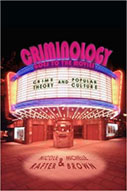Criminology Goes To The Movies: Crime Theory And Popular Culture

Authors: Nicole Rafter and Michelle Brown
Publisher: New York: New York University Press, 2011. 236p.
Reviewer: Judith A. Ryder | May 2013
Criminology Goes to the Movies is an innovative analysis of criminological theory and the representation of crime in the world of Hollywood cinema. The dual purpose of this very readable book is to make crime theory pleasurable and memorable, while seriously examining “criminology in the image.” Acknowledging the power of images to organize and shape how we think and—given the heavy emphasis on emotional elements in movies—how we feel about crime, authors Nicole Rafter and Michelle Brown invite readers to explore the overlap between the academic and the popular through the relatively new discourse of popular criminology.
As the subtitle (Crime Theory and Popular Culture) suggests, “criminology is hard at work in culture and culture is hard at work in criminology” and the cross-fertilization has transformed both. The Introduction briefly describes how traditional academic criminology tends to ignore cultural representations of crime, even though it is “the largest public domain in which thought about crime occurs.” Criminologists who may use films as a touchstone for classroom discussion or academic publications generally fail to theorize the intersection of film and scholarly projects. Though popular culture discourse lacks criminology’s rich theoretical framework for understanding crime, it recognizes that crime plays a huge role in the public imagination and that crime films address a range of cultural fears and anxieties absent in scientific writing. By depicting “the experiences that drive criminality,” film can reveal how values and emotional context shape criminal behavior—as well as resultant public policy. Rafter and Brown argue that a popular criminology can bridge the seemingly large gap between academic study and popular culture, and urge criminologists to accept cinema as a powerful cultural resource that first needs to be understood, and then theorized. This shift can enhance understanding of established theories, but of even greater import, popular criminology has the potential to expand criminology’s boundaries to enable new questions about criminality to emerge.
Ten chapters are chronologically organized according to theoretical developments, and focus on a specific criminological theory and a primary illustrative film. Each chapter summarizes the theory’s key points, describes the social context in which it was originally formulated and provides an historical analysis of the theory’s development. A synopsis of the chosen film provides readers with a common narrative before the example is used to demonstrate and expand upon aspects of the theory. Analyses often draw upon other, similar films to illustrate the ways in which they contribute to the development or advancement of a particular theoretical perspective. Of special interest is the author’s attention to the structure and format of films. Rather than simply describe plot points and narrative, they note the filmmakers’ stylistic techniques and how such methods inform the story and shape our beliefs about the meaning of crime and justice. Repeatedly, and from different angles depending on the theory and films under review, the authors urge readers to question, “how explanations of crime generated by popular culture coincide with those of formal criminology.” Included at the conclusion of each chapter is a guide to “Further Viewing,” a list of varying lengths of theoretically related movies not discussed in the text.
Rational choice theory, the oldest criminological perspective, begins the discussion of one of Hollywood’s most dependable explanations of criminal behavior: the rational actor making a calculated choice to engage in crime. Billy Wilder’s Double Indemnity, perhaps the definitive film noir, is used to visually demonstrate the cost-benefit analysis of crime. The protagonist, insurance salesman Walter Neff, weighs pleasure (“money and a woman”) against the interests and life of others. Actively choosing crime and self-interest, he must be punished: the consequence at the center of Classical theory.
The next two chapters concentrate on the role of individual failings to explain criminality, examining first biological theories (criminal anthropology and eugenic criminology, feeblemindedness, and biocriminology) and then psychological perspectives (psychology, psychiatry, and psychoanalysis). Biological theories are popular in film because they are so photogenic: Frankenstein provides a spectacular depiction of the criminal body in the form of Fritz, the hump-backed servant as well as, of course, the grotesque but more complex offender, The Monster. Alfred Hitchcock’s Psycho is the centerpiece for an analysis of psychological theories of crime (also included in the discussion are M, The Boston Strangler, and A Clockwork Orange). The chapter demonstrates the power of filmmaking to avoid reductionism and to portray how criminal behavior may be the product of deep and multiple psychological factors operating simultaneously. Though many sociologists rightly critique biological and psychological explanations of criminal behaviors, these theories increasingly address issues that sociology cannot, and an associated catalog of movies helps fill a gap in criminology texts.
Chapters Five, Six, and Seven appraise criminological theories that explain crime and criminal behavior in terms of social factors. In Chapter Five, social disorganization theory’s concern with cities and neighborhood effects are applied to New York City of the 1970s. Martin Scorsese’s Taxi Driver exemplifies both the theory’s interest in urban settings and immersive research methods. Various types of strain theory are reviewed in Chapter Six but most attention is devoted to an analysis of the complexity of institutional strain theory and Steven Soderbergh’s Traffic, which depicts the meaning of crossing boundaries between the normative and the socially illegitimate. Finally, Chapter Seven’s focus turns to social learning theories and differential association, and what has become a movie staple: subcultural theories of crime. Clint Eastwood’s Mystic River is used to graphically depict geographical, psychological, and sociological aspects of the subcultural perspective.
The next section of the book includes three critical perspectives in criminology, and one rather new and popular theory. The authors summarize critical theories and pair them with exemplary, and groundbreaking, films: labeling theory (Andrew Jarecki’s Capturing the Friedmans); conflict theory (Spike Lee’s Do the Right Thing); and feminist criminology (Ridley Scott’s Thelma & Louise). This set of three chapters counters many of mainstream criminology’s longstanding assumptions and raises new questions about how crime is socially constructed by those with power in terms of race, class, sex, and gender. A final chapter includes analyses of life course theory, which follows delinquent and criminal behavior across the life span. The chapter also addresses the related areas of developmental criminology and desistence. Several films are used to illustrate key points of each, and City of God (Meirelles and Lund) highlights their shared interest in time and the dynamics of criminality.
One may argue with the authors’ choice of theoretical and cinematic pairings, but therein rests the power and the beauty of the book. All crime, many scholars would agree, is not explained by any one theory, nor can one film do the job. But films can assume more than one operative view at a time and can draw on multiple theoretical perspectives simultaneously, a feat that is extremely difficult in academic publications. The selected films are complicated portrayals of victims and perpetrators and plots generally belie simplistic interpretations—and others exist that may work equally well. Just as cinephiles everywhere engage in lengthy arguments about details and messages in a film, so too should criminologists partake in the discussion, providing the conceptual framework through which to make meaning of cultural representations of crime and criminology.
The book’s prose is accessible and enjoyable. The authors neatly synthesize the intricacies of ten theoretical perspectives in language that is straightforward with a touch of humor. Though the chapters progress in the chronological order of their development, they need not be read in that manner; the content of each chapter can stand alone, allowing readers the freedom of “fast-forwarding and rewinding at will.” The films selected for analysis are either classics or have received recent critical acclaim, allowing easy access to those wishing to watch the films in conjunction with the readings. An appendix includes an alphabetical listing of films referenced in the text and their release dates.
Criminology Goes to the Movies is an unconventional analysis of films and their intersection with criminological theory through the emerging field of popular criminology. The succinct text offers instructors and students an exciting alternative to the all-too-often boring theory class, and provides criminologists interested in film and film buffs interested in crime potent narratives that enable all to visualize theory in action.
Reviewer: Judith A. Ryder, PhD; Associate Professor, Sociology & Anthropology Department, St. John’s University, Queens, New York.


